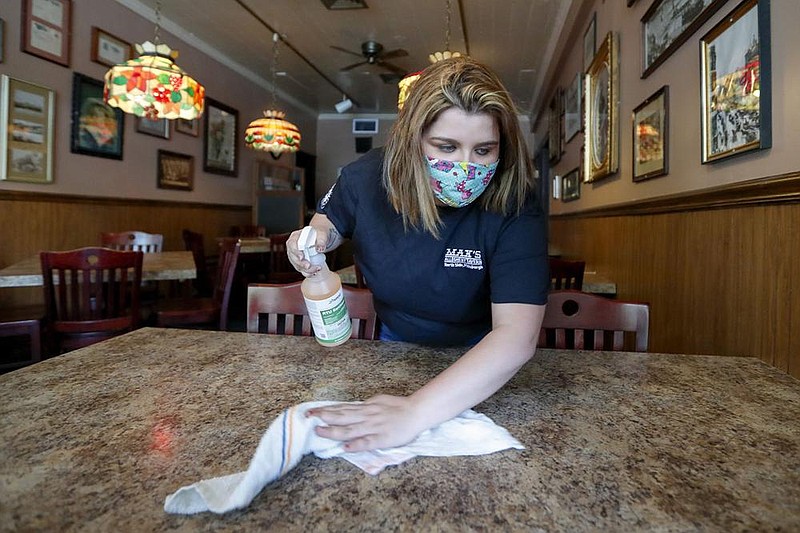A team of researchers is working on a project to ensure customers at dine-in restaurants won't be exposed to the virus that causes covid-19.
As more restaurants are reopening to the public, there remains limited research on how the virus can survive on different materials and transfer to a hand, then a nose or mouth. Kristen Gibson, a food scientist at the University of Arkansas, Fayetteville, and others are trying to change that.
She received a federal research grant of $987,000 to provide evidence that health precautions used across the food-service industry are working. Efforts include testing how long the SARS-CoV-2 virus can survive on materials used in "front of house" areas, such as table cloths, carpets, fabrics and furniture.
Gibson also plans to develop a fact-sheet so businesses can know what disinfectants work best. She is working on the the two-year project with researchers from Clemson University and the Centers for Disease Control and Prevention.
[CORONAVIRUS: Click here for our complete coverage » arkansasonline.com/coronavirus]
Most of today's standards, provided by the Food and Drug Administration, are for "back of house" areas where food is handled.
Research published in the New England Journal of Medicine shows SARS-CoV-2 can linger on plastic and stainless steel for up to three days and on cardboard up to 24 hours. Researchers tested the virus on a variety of surfaces, including paper and surgical masks, and it was present between 30 minutes and seven days, another study shows. They did not measure how the virus persisted on fabrics or while in contact with bodily fluids, such as respiratory droplets.
"We are interested in the 'front of house,' where customers and consumers can be and how to protect them from contracting covid-19 through indirect transmission," Gibson said.
To do this, she said researchers will use other respiratory viruses that will serve as models to indicate how SARS-CoV-2 will behave in testing conditions. They plan to compare the surrogate virus results against SARS-CoV-2 in collaboration with the CDC, which has sufficient biosecurity labs.
Gibson said the findings will be used to develop a national action plan and provide it to state and federal agencies, among other organizations. Another goal is to develop a guide so the food-service industry can find appropriate disinfectants.
Currently, there are 490 disinfectant products listed for use that are not based on scientific evidence, she said but "may meet criteria for inactivation of SARS-CoV-2." Researchers want to whittle that list down and validate which products are effective.
"We are very pleased with Dr. Gibson's involvement in this important and timely research," Jean-Francois Meullenet, senior associate vice president for agriculture and director of the Arkansas Agricultural Experiment Station, said in a statement. "I am confident she will be a strong asset to this multidisciplinary team of researchers."
According to the Bureau of Labor Statistics, about 60% of job losses related to covid-19 were in the food-service industry. By July many restaurants that were closed began reopening their doors, which led to an upswing in sales and the return of many laid-off employees. In August, industry jobs increased by 134,000, data shows. This is 2.4 million fewer jobs in August compared with February, before businesses began closing.
The U.S. Department of Agriculture's National Institute of Food and Agriculture funded the rapid response grant for Gibson's project. It is one of 17 awarded, totaling $13 million. Gibson said she would like to have most of the work done within the first year of the project.
Because of the timing, the study's findings may not have an impact on the current pandemic, she said. It does lay the groundwork for the next one.
"I think we will produce baseline evidence not just for this pandemic, but for effective food transmissions in general," Gibson said. "This goes beyond covid-19."
